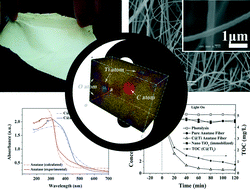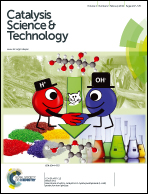Enhancement of photocatalytic activity for electrospun C@Ti/anatase fibers by lattice distortion under anisotropic stress
Abstract
A C@Ti/anatase nanoporous fiber, where C ions replace the positions of Ti (1–5%) in the lattice, was prepared quasi-in situ by electrospinning a titanate gel containing a polyethylene–polypropylene glycol additive. Compared with immobilized nano-TiO2 and anatase fibers, C@Ti/anatase fibers showed improved optical absorption for visible light. The improved photocatalytic activity of the fibers was further testified by its decomposition of 2,4,6-trichlorophenol (TCP) and methyl orange (MO) under visible light irradiation. The strengthened optical absorptivity was attributed to modifying the energy band structure in the lattice of anatase which results from isotropic and anisotropic stress. Based on analysis by first principle theory calculations, the C@Ti/anatase has been evidenced to be “softer” than the pure anatase ones, and easily affected by micro-residual stress. The lattice parameters of the C@Ti/anatase fibers became distorted when anisotropic compressive stresses were applied, resulting in a narrowed band gap.


 Please wait while we load your content...
Please wait while we load your content...